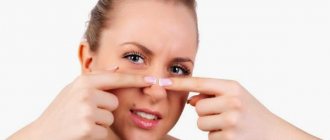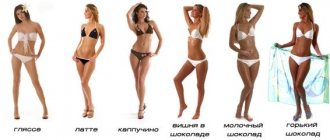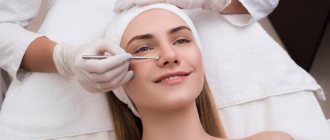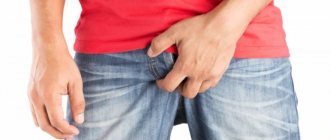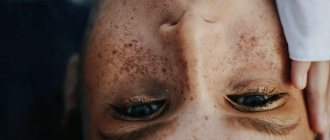Milium (horny cyst, whitehead, “millet”) is an epidermal cystic formation at the mouth of the hair follicle, looking like a small white grain. Typically, milia are localized on the face in areas with relatively thin skin, very rarely on the body, and exist for a long period without any changes. Milia are a fairly common cosmetic problem and can occur at any age. Whiteheads appear especially often during puberty; also often found in newborn babies (neonatal acne). Female representatives are more susceptible to the appearance of milia.
Causes
Milia occur in patients with a thick form of oily seborrhea, characterized by hyperfunction of the sebaceous glands and changes in the chemical composition of sebum and creating a favorable background for the development of acne.
There are closed comedones - whiteheads (milia) and open comedones - blackheads (blackheads). Thick seborrhea is also characterized by the appearance of deep cysts of the sebaceous glands - atheromas and acne vulgaris. Milia have the appearance of small rounded dense nodules of a white-yellowish hue, 0.5-3 mm in size with clear boundaries, protruding above the surface of the skin and resembling millet grains (popular name - “millet”). Milium is characterized by an uninflamed head, since the whitehead does not have a natural outlet and contact with the environment. Milia do not change in size for a long time. When microorganisms enter the milium, inflammation may develop with the formation of an abscess. Milia (milia) can often be found on the wings of the nose in recently born babies; they are considered borderline conditions in newborns and soon disappear spontaneously without any treatment.
Milia are recognized based on an examination of the skin by a dermatologist-cosmetologist based on characteristic external signs.
Why do pimples occur?
White pimples
Newborn acne
Their cause is too much maternal hormones in the baby’s body. After birth, the baby’s body is saturated with mother’s hormones, which have a direct effect on the condition of the skin. In turn, this entails so-called hormonal acne. From a scientific point of view, they are called neonatal acne. Typically, such pimples are localized on the face, but they do not need to be treated. You just need to keep your skin dry and clean. Acne is not contagious and does not occur because you do not keep your baby clean enough. If pimples are noticed in the area of the face, neck and hair, then this is acne.
Overactive sebaceous glands: acne
When a child is born, his glands are active and therefore acne appears. These pimples look like blackheads that cover large areas of the skin. Typically, the rash appears a week after birth and does not go away for about a month. There is no need to worry if it does not interfere with the child in any way. This type of pimples is characterized by the accumulation of pus under the skin of a white-yellow hue, they have a red base and a white tip.
Milia
Small white pimples on a baby's face that look like dots the size of a pin's head are called milia. This is an accumulation of sebaceous gland secretion in the ducts. They cannot be eliminated in any way, but they will go away on their own. If you try to squeeze them out or cauterize them, you can cause problems in the form of inflammation.
Red pimples
Allergic reaction
It often occurs due to a product that the mother ate, since not only beneficial substances, but also allergens are transmitted to the baby through breast milk. A similar reaction can occur with feeding formulas. To prevent allergies, it is better to write down all the foods you eat and monitor your baby’s condition. If you notice red pimples in a child 18 hours after eating food, then the product that caused them should be removed from the diet. Allergies can also be caused by washing powder; you should use only special types. Finally, animal fur, plant pollen, and so on become allergens. A typical sign of an allergy is peeling, crusting and a small rash on red spots. A child with an allergic reaction should definitely be shown to a doctor.
Prickly heat
If a child is dressed too warmly or is not wrapped up enough, then he sweats very actively. His skin remains damp all the time and is covered with pimples. They first appear in the neck area, and then move to the face. To avoid prickly heat, monitor the temperature in the room; it should not exceed 18-22 degrees Celsius. Choose clothes for your baby exclusively from natural fabrics, selected according to the weather.
Dysbacteriosis
In this case, pimples are only a symptom of an intestinal illness, so you should not self-medicate, but consult a doctor.
Treatment of milia
Milia do not go away on their own; it is almost impossible to get rid of them with the help of cosmetics. Under no circumstances should you squeeze out milia yourself, as this will damage the hair follicle and sebaceous gland. Such self-medication often leads to the subsequent formation of a larger acne or the addition of an infection, which can cause the formation of a rough scar.
Treatment of milia is carried out by a dermatologist and consists of opening and removing the cyst capsule with its contents. The choice of removal method depends on the location, number, size and depth of the milia. For single milia, mechanical removal is carried out (using a sterile needle and curettage) with preliminary and subsequent antiseptic treatment of the skin. Small wounds left after such a procedure heal on their own without leaving a trace.
For multiple whiteheads, modern methods are used - removal of milia with a laser, radio wave method or electrocoagulation. The crusts formed at the cauterization site disappear on their own within 10-14 days. Removing more than 10 elements at one time is not recommended to avoid significant trauma to the skin and disruption of the sebaceous glands.
What does a newborn look like?
If the birth goes well, immediately after the birth of the newborn baby, the mother is placed on her stomach. His skin can be bright pink, or it can be pale, his hands and feet have a bluish tint. This scares young mothers if they have heard or read something about hypoxia and cyanosis before. But if the doctors in the delivery room are calm and do not provide resuscitation measures, then this is a variant of the norm. A healthy child can be like this in the first minutes of life. In addition, the newborn's body is covered with vernix - the baby looks as if it has been smeared with cream cheese. And this is also normal, although unattractive. Lubricant plays an important role in protecting the skin from germs, so the baby’s skin is only lightly blotted without being completely wiped.
5-10 minutes after birth, the newborn’s skin becomes bright pink, almost red. This is a normal condition - physiological erythema . The air pressure is less than the pressure of the fluid in which the baby was in utero. When the skin ceases to experience resistance, blood actively flows to it. The body gets used to the new form of life. Gradually, the blood vessels will narrow, and the skin will become its usual pink color by the end of the week in full-term babies and after 2-3 weeks in premature babies.
Prevention of milia
To prevent the appearance of milia, careful facial skin care is required using cleansers and moisturizers appropriate to the skin type, scrubs, peels, cosmetic masks that normalize the activity of the sebaceous glands; elimination of provoking factors, proper and rational nutrition, healthy lifestyle. Salon cosmetic procedures, including mechanical, ultrasonic, vacuum facial cleansing, peelings (chemical, mechanical - microdermabrasion), laser resurfacing, are quite effective in preventing the appearance of milia.
Erythema toxicum
By the second or third day of life, 70% of full-term newborns develop a small red rash on the skin. Rarely, this condition occurs in premature babies. First, spots appear, and within an hour a yellow bump 1-2 mm in size forms in the center. Elements of the rash are located on the face, torso, arms and legs, and can merge with each other. The cause of erythema toxicum is unknown, but the rash goes away without treatment in 1-7 days and is not dangerous.
If the clinical picture is atypical or other symptoms are present, the doctor will prescribe additional examination to rule out other causes of the rash, such as infection.
Infant acne
The same rash in children after three months of age is called infant acne. It persists as persistent acne of newborns or reappears at 2-3 months. It differs from newborn acne only in the age of the children and the duration of the rash. Self-resolution occurs within 6-12 months. Infantile acne may be a risk factor for acne during adolescence.
Prickly heat
Develops in children from the second week of life when overheated. The rash has different manifestations: small red spots, nodules, pustules or blisters in the thickness of the skin. Miliaria can occur on any part of the body: in the folds, on the face, scalp, torso, arms and legs. The cause of the rash is blockage of the sweat glands.
There are several factors contributing to this:
- high room temperature;
- increased body temperature in a child;
- thick clothing, non-breathable fabric, for example, an oilcloth mattress cover;
- lying in one position for a long time.
Treatment consists of general care:
- daily bathing without soap and other chemicals;
- using lighter and looser clothing;
- maintaining the air temperature in the room at 22-24 degrees C;
- ventilation.
When these conditions are met, prickly heat disappears within a few hours. The recommendations listed above also apply to prevention.
For walks outside, the child is dressed like an adult plus one layer of clothing. No need to re-wrap. There is also no need to wear a cap in warm weather.
During the cold season, undress your child during a long stay in a store, shopping center or other premises. While awake, place your baby on his stomach and hold him vertically in your arms to diversify his movements.
Mastocytosis
A rare disease that can appear at an early age, sometimes even from birth. Outwardly, it resembles allergic urticaria, but spots and blisters last longer, and when the exacerbation subsides, pigmentation remains. A typical diagnostic test is the appearance of blisters on the skin due to mechanical irritation of areas of pigmentation.
Treatment for childhood forms of the disease is not required; recovery occurs spontaneously within several months, sometimes several years. If itching is present, antihistamines are used.
Newborn acne
20% of newborns develop a rash similar to teenage acne from the third week of life. Small pustules surrounded by a red halo. They are located on the face, head, chest, shoulders, and less often on the stomach. The condition is called “acne,” although in the literature the term “cephalic pustulosis” (from the words “cephalo” - head and “pustule” - abscess) or “neonatal pustulosis” is more often used. The main two reasons are the influence of maternal hormones during breastfeeding and the colonization of the skin by microorganisms. Elements of the rash resolve without treatment after 1-3 months. This condition is not dangerous, does not cause discomfort to the child and leads to independent recovery, so there is no need to prescribe medications. The exception is severe cases when the rash is profuse, leads to secondary infection or heals with the formation of scars.
Molluscum contagiosum in children
Molluscum contagiosum is more common in children than in adults. Children up to one year old practically do not get sick with molluscum contagiosum. This is due to the fact that in the first year of life the child’s circle of contacts is small: the child moves in a limited space, often specially prepared for him and under the strict supervision of adults, without trying to come into contact with other children. But as soon as a child begins to actively communicate and independently explore the world, the threat of becoming infected with molluscum contagiosum increases sharply.
The peak incidence of molluscum contagiosum in children occurs between the ages of 2 and 6 years. Immunity at this age is still weak. Children become infected through toys or dirty hands. The virus penetrates the skin in the place where the integrity of the skin is damaged - through wounds, abrasions, cracks. Children's skin is delicate and sensitive, and the activity of a preschool child is great. As a result, numerous microtraumas occur, opening the way for infection. Cases of infection with molluscum contagiosum while swimming in the pool have also been described.
From 6 to 10 years, the incidence of molluscum contagiosum decreases. Instilling household hygiene skills is of great importance. The sooner your child starts taking care of clean hands, the better.
Atopic dermatitis
Atopic dermatitis is a disease of an allergic nature, which is accompanied by chronic inflammation of the skin. The causes of an uncontrolled allergic reaction in infants are:
- food allergens – animal protein, soy products, some types of vegetables;
- airborne allergens - household dust, pollen, pet hair, tobacco smoke, etc.;
- pathogenic microflora - fungi, viruses, bacteria.
In newborns, the erythematous-squamous form of atopic dermatitis with signs of an acute inflammatory reaction is most often diagnosed:
- skin hyperemia;
- peeling;
- flat small papules.
Red spots are localized on the arms and legs in the folds , on the sides of the neck, on the back of the hands and on the cheeks. Children with atopic dermatitis are advised to regularly cleanse and moisturize their skin [6]. Anti-inflammatory drugs are prescribed only for extensive skin lesions that impair the baby's quality of life - in this case, you should consult a pediatrician.
For daily care, it is recommended to use STELATOPIA emollient cream . Research [5.1] has shown that emollient:
- In 90% of cases, it reduces increased dry skin [5.1] and reduces the likelihood of clinical signs of AD by 51% [10]
- Relieves itching sensation in 91% of cases [5.1]
- Reduces inflammation after 32 hours[11]
